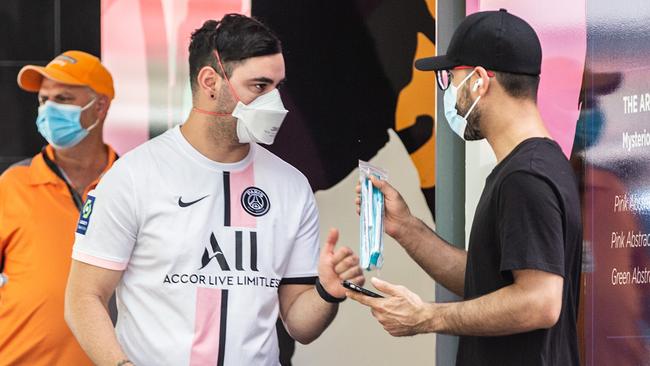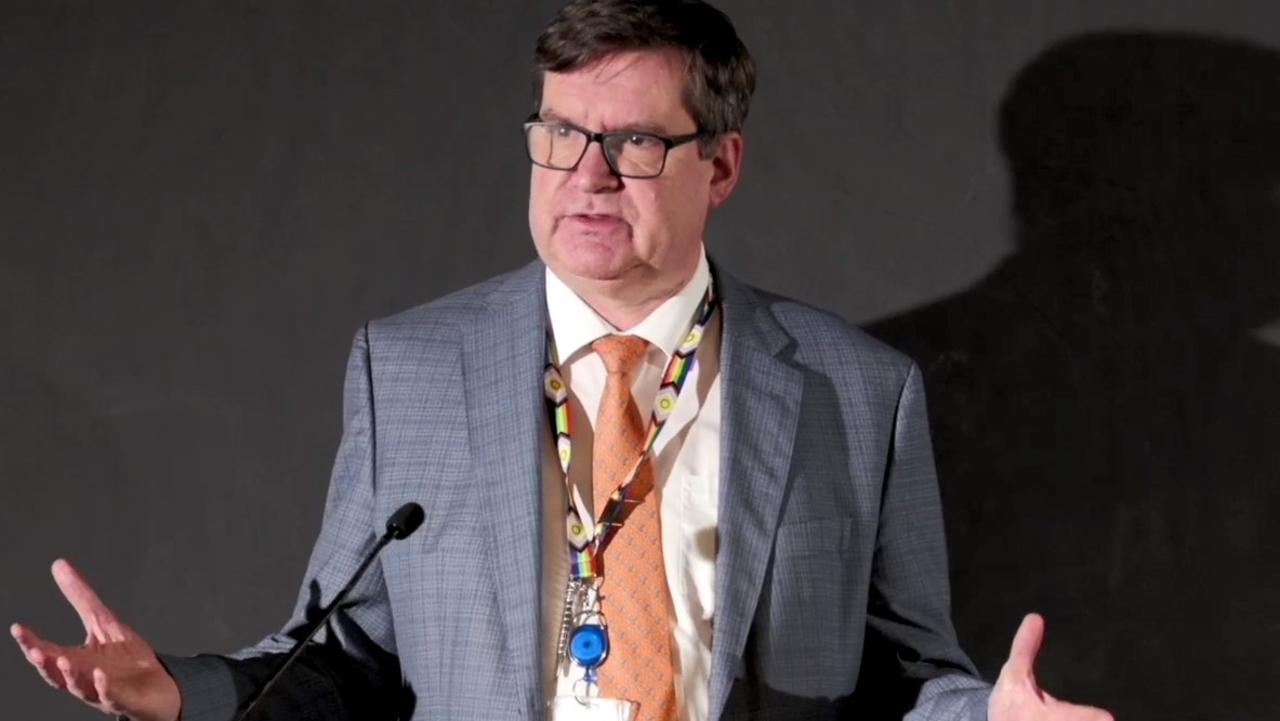‘Code Brown’ called as Omicron puts extreme pressure on hospitals
An agreement with Victoria’s private hospitals has been activated to cover the dire workforce crisis in Covid-hit public hospitals.
Coronavirus
Don't miss out on the headlines from Coronavirus. Followed categories will be added to My News.
• This coronavirus article is unlocked and free to read in the interest of community health and safety. Tap here to see the latest great value offer for full digital access to trusted news from the Herald Sun and Leader.
Tens of thousands of health workers from private hospitals will be made available to cover dire staff shortages in Covid-hit public hospitals.
Federal Health Minister Greg Hunt has activated an agreement with private hospitals – which was drawn up as a last resort measure at the start of the pandemic – to tap into their surge capacity during the Omicron wave.
It means up to 57,000 nurses and more than 100,000 staff across the country will be available for state governments to bring in to publicly run hospitals.
The move will provide extra support for Victoria’s hospitals after a code brown was ordered by the state government on Tuesday.
Mr Hunt said he had “strong confidence in the Victorian hospital system and strong confidence in its preparedness”, as he acknowledged that workforce shortages were the “principal challenge” in Omicron-affected areas.
The national medical stockpile has also been activated to cover any shortages of personal protective equipment in hospitals.
SUPPORT FOR ‘CODE BROWN’ CALL
Mr Hunt and federal chief medical officer Professor Paul Kelly backed Victoria’s “code brown”, which has been called across metropolitan Melbourne and six regional hospitals.
Mr Hunt said he supported the decision to cover workforce shortages caused by the Omicron wave, while Prof Kelly said it was “good governance”.
“That is standard practice in hospital systems around the world,” Prof Kelly said.
“They’re doing the right thing.”
Mr Hunt dismissed calls to bring in the Defence Force to man Victorian hospital wards.
He said private hospital workers were the “safest, most important and most readily available resource” and represented an “enormous capacity as yet unutilised” during the crisis.
‘The people who have the capacity to step straight into the hospital environment … are the nurses, doctors and care staff within the private hospital system,” Mr Hunt said.
“(They have) exactly the set of skills that one would want in a Covid ward or in a public hospital.”
“We prepared for this moment.”
It comes as an emergency department nurse has revealed one patient’s “unbelievable” act to try and get a Covid test.
Royal Melbourne Hospital emergency department nurse unit manager Susan Harding said the caller faked chest pain in order to receive a PCR test.
“We had a patient last week that was desperate for a PCR,” she said on Tuesday.
“They called triple-0, called an ambulance under the guise of having chest pain, they presented to the emergency department and were fast-tracked down to a resuscitation room at which point they declared they didn’t have chest pain and that they really wanted a PCR and wanted it quickly.
“That is an unbelievable misuse of resources.”
The state government brought in the code brown measure due to the number of healthcare workers either diagnosed with Covid or forced to isolate as close contacts.
Health services under the code have the ability to postpone or defer care that is not urgent, and will also be able to discuss cancelling planned leave with their staff.
It’s estimated around 5000 workers are off work daily at the moment.
Deputy Premier James Merlino said busy hospitals had asked for the declaration, and that the sector was under “extreme pressure”.
“We’ve reached a point in our health system where it’s juggling severe workforce shortages … alongside a vast number of patients with Covid-19 needing hospitalisation,” he said.
“We could we’ll get to over 2500 hospitalisations and more over the next few weeks.”
The six regional health services affected are Barwon Health, Grampians Health, Bendigo Health, Goulburn Valley Health, Albury Wodonga Health and La Trobe Regional Hospital.
Elective surgery and IVF treatments will remain at current levels, while more hospital at home services will also be used.
It is estimated the new changes could be in effect for up to six weeks.
The last code brown was during a nightmare thunderstorm asthma event in 2016.
The code brown was triggered because more than 4000 health services staff have Covid or are in isolation, and hospital admissions have now tipped past 1500 cases.
Staff working on outpatient services will prioritised to make sure intensive care and other key sectors are not overwhelmed.
Code brown plans will come into effect by midday Wednesday.
Austin Health’s chief executive Adam Horsburgh welcomed the code announcement.
“The number of admissions for Covid is growing fast and we believe now is the right time — we don’t want to leave this too late.”
Another major change is that ambulance patients will be able to be “rapidly offloaded” at emergency departments, rather than paramedics sitting with them until they are admitted.
This rule change will free ambulance services across the community.
There will also be more specialist “streaming sites” where Covid patients are treated in an effort to ease pressures on the wards currently handling hundreds of cases.

20,180 CASES, 22 DEATHS IN VICTORIA
Victoria has seen another dip in Covid cases, with 20,180 new cases announced on Tuesday.
But 22 people died with the virus overnight, authorities revealed.
Hospital admissions have also dropped from 1229 Victorian patients to 1152 in 24 hours.
Meanwhile, 127 people are receiving intensive care, including 42 fighting for life on a ventilator.
Nearly one in four eligible Victorians have received a booster vaccine, with the jab rate now at 24 per cent.
The latest Covid wave may have reached its peak, and authorities are optimistic that case numbers will start to fall.
Chief health officer Brett Sutton said on Monday there were promising signs the state might be on the verge of overcoming the outbreak.
But he warned that hospital admission numbers would continue to surge for several more weeks.
“There’s a lot of uncertainty, but I do think we’re reasonably close to a peak, if we’re not at a peak already,” Professor Sutton said.

“Clearly the picture from around the world – South Africa peaked in a reasonably short period of time, the UK looks to have peaked, some states in the US, New York, New Jersey look to be peaking with their case numbers – but we’ve got a high proportion of PCR tests coming back positive so it does mean there are a lot of people out there who don’t know their status.”
Cases have been on a steep climb since the variant exploded last month, and the state recorded 22,429 infections and six deaths alone on Monday.
Prof Sutton warned that Victoria’s true case count could be much higher than the official figure.
“When you’ve got 30 odd per cent of (PCR) tests coming back positive, that means there’s a lot of undetected cases as well,” he said.
“It’s a pretty strong indication that there might be at least that number again out there who are positive who don’t know.
“There’ll be a lot of people, who, because they’re double-vaccinated or triple-vaccinated, will have very mild symptoms or no symptoms at all.”
Prof Sutton said he expected hospital admissions would rise in Victoria through January, before peaking in February. “
Those hospital numbers are going to increase,” he said.
“There’s a lag compared to our daily case numbers and over the next few weeks we will see hospital numbers go up. We really need to make sure we’re protecting each and every single person who is eligible for a booster to avoid hospital.”
Australia’s chief medical officer, Paul Kelly, predicted there would be large numbers of cases over the next few weeks before infections peaked.
It is anticipated that most states, aside from WA, will see a peak in cases in coming weeks, followed by a reduction.
An initial three million rapid antigen tests, of Victoria’s bulk order of 44 million, arrived on Monday, with plans to distribute them to critical workforces and vulnerable people.




